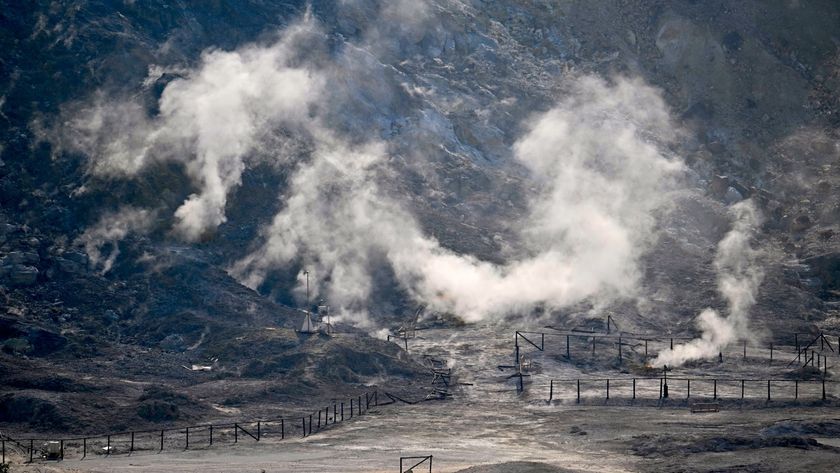
Antarctic Lava Lake Huffs and Puffs Like a Sleeping Dragon
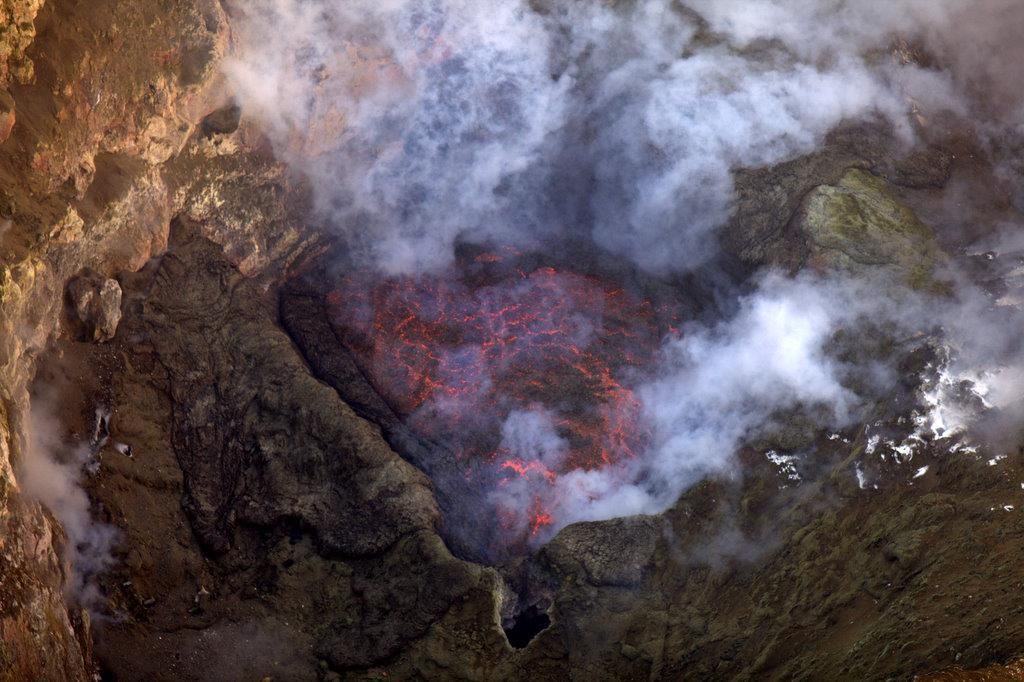
The coldest place on Earth is also one of the rare spots where a roiling lava lake offers a window into the heart of a volcano.
At Erebus volcano in Antarctica, a long-lived lava lake puffs steam and launches lava bombs at scientists who scale its slopes, hoping to unravel the mysteries of how volcanoes work. (Lava bombs are flying blobs of molten rock.)
"We think lava lakes are really the top of a magma chamber, so by studying lava lakes we can see what's happening in the guts of the volcano," said Philip Kyle, a volcanologist at New Mexico Tech in Socorro, who has visited Erebus since the late 1960s.
Erebus has been continuously active since as early as the 1970s. For more than 40 years, researchers like Kyle have climbed its 12,450-foot-tall (3,794 meters) peak during the brief summer, installing a battery of monitoring equipment that transforms Erebus into one of the most intensely watched volcanoes in the world. [Gallery: Erebus Volcano's Amazing Lava Lake]
In the early decades, scientists gathered just a few precious weeks' worth of data each summer at Erebus. Now, despite the harsh climate, everything from earthquake monitors to infrared cameras perch on the volcano year-round. Instruments also track the swelling and sinking of the volcano's surface, snooping on magma pulsing underground; listen to infrasound (sound below the range of human hearing); and sniff gases escaping into the air.
The dragon's breath
One of the remarkable discoveries to come from this long encampment is how regularly the lava lake huffs and churns, like a sleeping dragon. "I like to say Erebus is breathing, though I've been told off because Erebus can only breathe out," Kyle said.
Sign up for the Live Science daily newsletter now
Get the world’s most fascinating discoveries delivered straight to your inbox.
Kyle's collaborator, Clive Oppenheimer, a volcanologist at the University of Cambridge, first noticed the lake's reliable pattern several years ago, from measuring its never-ending gas plume. The total amount of gas — mostly an equal measure of carbon dioxide and water, with a little sulfur dioxide and hydrogen chloride — rises and falls in a 10-minute-long cycle. The composition of the gas also switches on the same cycle.
But the brief summer research season meant scientists weren't sure if the phenomenon occurred only on their watch. Perhaps the dragon awoke in winter.
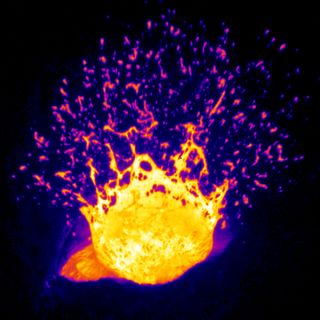
Now, with year-round equipment, Erebus investigators have proved the cycle persists year-round, varying between five and 18 minutes since 2004, according to a study to be published June 2014 in the journal Earth and Planetary Science Letters.
"The behavior has stayed remarkably constant, which is actually quite unusual for volcanoes," said Nial Peters, lead study author and a geophysicist at the University of Cambridge in the United Kingdom.
The new study also reports other intriguing behavior in the bubbling lake. For instance, the lava heaves in concert with its 10-minute gas cycle, its surface rising and falling by about 6 to 10 feet (2 to 3 m), Peters said. And lava cooling on the lake surface cracks and flows outward at a speed that matches the fluctuating gases. "Think of the lake as a bowl sitting on top of a pipe, and as fresh batches of magma come up into the bottom they rise up and spread out," Peters told Live Science's Our Amazing Planet. "That's what we see in the velocity flow outward from the center of the lake. It looks like a thick, treacly liquid, which is gradually convecting."
A rare view
Lava lakes are rare — there are only four long-lived lakes on Earth, because the volcano must continuously supply lava to the surface. There are lakes at Erebus, Hawaii's Kilauea volcano, Ethiopia's Erta Ale volcano, and Nyiragongo volcano in the Democratic Republic of the Congo. [Photos: The World's Five Most Active Volcanoes]
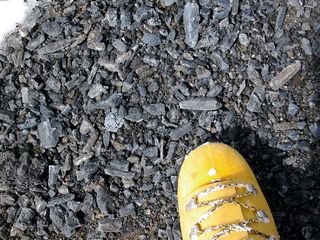
Erebus volcano's magma is a rare type called phonolite, up to 100 times more viscous than the basalt at Kilauea in Hawaii and Erta Ale in Ethiopia. Though Erebus is the only active volcano with phonolite lava, its twin is Kilimanjaro in the East African Rift, Kyle said. Both are steep-sided, cone-shaped phonolite volcanoes rising from rifts, where the Earth's crust is stretching apart. Looming up from Ross Island, Erebus is visible from McMurdo research station and New Zealand's Scott Base.
The long-term observations at Erebus volcano's lava lake are among the only rigorous studies of these valuable windows into magmatic systems, said Matt Patrick, a volcanologist with the U.S. Geological Survey's Hawaii Volcano Observatory, who was not involved in the study.
"The Peters paper represents a big step in understanding active lava lakes, in large part due to the uniquely detailed observations they have made of the lava lake activity," Patrick said.
How it works
With their bounty of data, the members of the Erebus team are now moving toward their next big goal: explaining how the volcano works.
"That's the $64,000 dollar question," Kyle said of the oddly predictable plumbing.
Here's what might cause the steady exhalations. Think of blobs rising and falling in a lava lamp. Now put those blobs in an underground pipe that feeds the lava lake from a deeply buried magma chamber. Lava moves up and down the pipe — a flow and counterflow similar to a lava lamp, according to a model in a separate study to be published in the same issue of the journal Earth and Planetary Science Letters.
"The physics of what's going on are fairly different, but it's an easy analogy," said Peters, who is co-author on the "lava lamp" study. "Batches of fresh magma come in as blobs, not as a continuous stream."
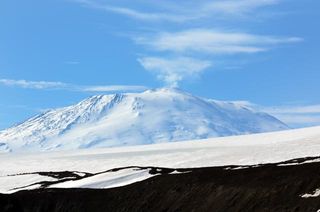
But just like a real body, this "breathing" comes from a different part of the volcano than its burping eruptions. Erebus erupts when a large gas bubble emerges and bursts in the lake, splattering lava on the surrounding slopes. Some of the volcano's lava bombs are nearly bus-size.
At Erebus, these belches have a different composition than the gases that ebb and flow every 10 minutes, researchers discovered. The investigators think this difference means that the bomb-launching bubbles come from deeper in the volcano.
"It looks like the two behaviors are very decoupled from each other," Peters said. The gas cycling continues even when eruptions suddenly lower the lava lake level, he noted.
Computer modeling of the upper and lower volcanic plumbing will help explain this strange set of behaviors and provide insight into the inner workings of other volcanoes, Peters said.
But there's a hurdle.
"Basically, all the measurable properties of the lava are still up for grabs," Peters said. Even the lava's temperature is only a guess — it's never been directly measured. That's partly because of the risk of death from flying bombs, and partly because the lake is ensconced in a 330-foot-deep (100 m) crater. "The pipe dream is to do what's called volcano fishing, which is instruments dangled from cables into the lake," Peters said.
Email Becky Oskin or follow her @beckyoskin. Follow us @OAPlanet, Facebook and Google+. Original article at Live Science's Our Amazing Planet.


